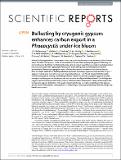Files in this item
Ballasting by cryogenic gypsum enhances carbon export in a Phaeocystis under-ice bloom
Item metadata
| dc.contributor.author | Wollenburg, J. E. | |
| dc.contributor.author | Katlein, C. | |
| dc.contributor.author | Nehrke, G. | |
| dc.contributor.author | Nöthig, E. M. | |
| dc.contributor.author | Matthiessen, J. | |
| dc.contributor.author | Wolf-Gladrow, D. A. | |
| dc.contributor.author | Nikolopoulos, A. | |
| dc.contributor.author | Gázquez-Sanchez, F. | |
| dc.contributor.author | Rossmann, L. | |
| dc.contributor.author | Assmy, P. | |
| dc.contributor.author | Babin, M. | |
| dc.contributor.author | Bruyant, F. | |
| dc.contributor.author | Beaulieu, M. | |
| dc.contributor.author | Dybwad, C. | |
| dc.contributor.author | Peeken, I. | |
| dc.date.accessioned | 2018-08-23T13:30:06Z | |
| dc.date.available | 2018-08-23T13:30:06Z | |
| dc.date.issued | 2018-05-11 | |
| dc.identifier | 255536809 | |
| dc.identifier | a41dc629-4ab6-480d-8b4e-4d0efe5629fe | |
| dc.identifier | 85047148229 | |
| dc.identifier.citation | Wollenburg , J E , Katlein , C , Nehrke , G , Nöthig , E M , Matthiessen , J , Wolf-Gladrow , D A , Nikolopoulos , A , Gázquez-Sanchez , F , Rossmann , L , Assmy , P , Babin , M , Bruyant , F , Beaulieu , M , Dybwad , C & Peeken , I 2018 , ' Ballasting by cryogenic gypsum enhances carbon export in a Phaeocystis under-ice bloom ' , Scientific Reports , vol. 8 , 7703 . https://doi.org/10.1038/s41598-018-26016-0 | en |
| dc.identifier.issn | 2045-2322 | |
| dc.identifier.uri | https://hdl.handle.net/10023/15860 | |
| dc.description.abstract | Mineral ballasting enhances carbon export from the surface to the deep ocean; however, little is known about the role of this process in the ice-covered Arctic Ocean. Here, we propose gypsum ballasting as a new mechanism that likely facilitated enhanced vertical carbon export from an under-ice phytoplankton bloom dominated by the haptophyte Phaeocystis. In the spring 2015 abundant gypsum crystals embedded in Phaeocystis aggregates were collected throughout the water column and on the sea floor at a depth below 2 km. Model predictions supported by isotopic signatures indicate that 2.7 g m-2 gypsum crystals were formed in sea ice at temperatures below -6.5 °C and released into the water column during sea ice melting. Our finding indicates that sea ice derived (cryogenic) gypsum is stable enough to survive export to the deep ocean and serves as an effective ballast mineral. Our findings also suggest a potentially important and previously unknown role of Phaeocystis in deep carbon export due to cryogenic gypsum ballasting. The rapidly changing Arctic sea ice regime might favour this gypsum gravity chute with potential consequences for carbon export and food partitioning between pelagic and benthic ecosystems. | |
| dc.format.extent | 9 | |
| dc.format.extent | 1675367 | |
| dc.language.iso | eng | |
| dc.relation.ispartof | Scientific Reports | en |
| dc.subject | GE Environmental Sciences | en |
| dc.subject | 3rd-DAS | en |
| dc.subject.lcc | GE | en |
| dc.title | Ballasting by cryogenic gypsum enhances carbon export in a Phaeocystis under-ice bloom | en |
| dc.type | Journal article | en |
| dc.contributor.institution | University of St Andrews. School of Earth & Environmental Sciences | en |
| dc.identifier.doi | 10.1038/s41598-018-26016-0 | |
| dc.description.status | Peer reviewed | en |
This item appears in the following Collection(s)
Items in the St Andrews Research Repository are protected by copyright, with all rights reserved, unless otherwise indicated.

